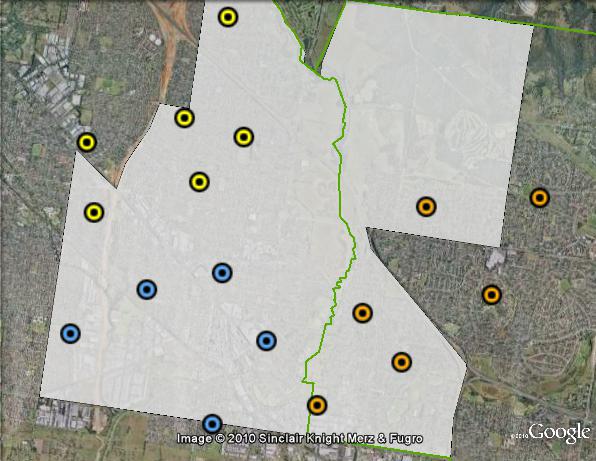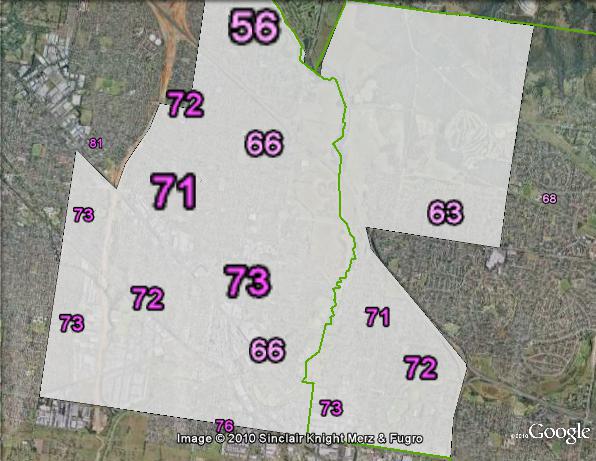ALP 18.7%
Incumbent MP
John Pandazopoulos, since 1992.
Geography
Southeastern Melbourne. Dandenong covers parts of the City of Casey and the City of Greater Dandenong, specifically the suburbs of Dandenong, Doveton and Eumemmerring and parts of the Dandenong North, Endeavour Hills, Keysborough and Noble Park.
History
Dandenong has existed as an electoral district continuously since 1904. For the first half of the 20th century, Dandenong was dominated by the Liberal Party and its predecessors. The ALP only won the seat twice, in 1929 and 1952. The ALP won the seat off the Liberal Party in 1969, and have held the seat ever since.
The seat was won in 1992 by John Pandazopoulos. He served as a minister in the Bracks government from 1999 to 2006.
Candidates
- Christopher Blackburn (Democratic Labor Party)
- Matthew Kirwan (Greens)
- John Pandazopoulos (Labor)
- Dale Key (Liberal)
- Damien Latcham (Family First)
Political situation
Dandenong is a safe Labor seat.
2006 result
| Candidate | Party | Votes | % | Swing |
| John Pandazopoulos | ALP | 17,126 | 58.53 | -6.85 |
| Cameron Nicholls | LIB | 7,287 | 24.91 | -1.38 |
| Peter Dorian | FF | 2,426 | 8.29 | +8.29 |
| Peter Blair | GRN | 2,420 | 8.27 | +1.97 |
2006 two-candidate-preferred result
| Candidate | Party | Votes | % | Swing |
| John Pandazopoulos | ALP | 20,077 | 68.67 | -1.64 |
| Cameron Nicholls | LIB | 9,162 | 31.33 | +1.64 |
Booth breakdown
Polling booths in Dandenong have been divided into three areas: those in the north of the seat, those in the east, and the remainder in between. The ALP’s majority varied from 67% in the north to 71% in the centre.

| Voter group | GRN % | FF % | ALP 2CP % | Total votes | % of votes |
| North | 7.14 | 8.06 | 67.07 | 9,627 | 32.93 |
| Central | 9.71 | 8.12 | 71.61 | 7,521 | 25.72 |
| East | 7.47 | 9.02 | 69.35 | 6,183 | 21.15 |
| Other votes | 9.12 | 8.14 | 66.79 | 5,908 | 20.21 |



Interesting in South East Metro as and a few others that the combined DLP/FFP are overtaking the Greens in some strong ALP seats .
http://www.abc.net.au/elections/vic/2010/guide/dand.htm
Maybe the ALP should have placed the Greens last
Tony, I think you’re reading too much into the Dandenong results. The Greens have held their vote in Dandenong when compared to 2006, in what has always been a tough seat for them – and Family First’s vote has *halved*. The DLP had the top position on the ballot paper, which is significant in Dandenong given its demographics. If you compare the South Eastern Metro results in 2006 for FF, the CDP and Geraldine Gonsalvez’s independent ticket (equal to 6.32) to the 2010 results for the DLP, FF and CDP (6.72) the combined vote has barely grown at all, which must be a bit disappointing for you given Geraldine’s profile and the better resourcing you’ve put into the DLP campaign this time around.
In fact, given that you’d expect the DLP to get a core vote of 1-2% (consistent with your senate polling), and that you’d not stood a candidate in Dandenong in the previous state election, it looks like you’ve grabbed votes from Family First rather than making any serious inroads to the major party vote. It’s really not surprising that the DLP would pick up ex-Family First voters and the Greens wouldn’t.
a) Labor didn’t go to preferences.
b) The DLP or FF would never preference Labor over the Libs unless the later fielded a candidate who had a life style contrary to their beliefs..
Although I do find it a little odd considering at the federal election, DLP voters preference the ALP at roughly 60%. This is against the HTV cards.
@Imaginative Nickname – It’s not surprising that many DLP voters preference the ALP, as there’s a well known pattern here in the Victoria of the DLP significantly increasing their vote when they’re ahead of the ALP on the ballot paper.
DLP results in the area, from the ABC site:
Dandenong: 6.5% (top of ballot)
Cranbourne: 2.9%
Narre Warren North: 2.7% (top of ballot)
Mulgrave: 1.9%
Narre Warren South: 1.4%
Lyndhurst: 1.1%. (FF got 4.5% – they got the top spot here.)
Just looking at that, I’d say being on top of the ballot has a fair bit to do with the DLP vote; Narre Warren North is the main exception.
@Bird of Paradox – they also got about 3.0% in Clayton while they were top of the Ballot, but only got about 1.6% in the neighbouring seat of Oakleigh, where they weren’t top of the ballot. They were, however, handing out HTVs in Oakleigh, so even with some campaigning, they still only got 1.6% (that’s the first time in my life that I’ve ever been given a DLP HTV).
As the Greens candidate I am more than pleased at the final result, a 0.5% increase to 8.77% (one of the better results in outer suburban areas) without the advantage of top of the ballot like 2006. But how much does top of the ballot make? I am interested in what others think?
Being top of the ballot is worth different amounts in different seats. Broadly speaking it appears to be inversely correlated with education levels. So in a seat where most people are well educated (eg Hawthorn) it might be worth as little as 0.2%. In a seat with very low levels of education it can be worth much more. The most extreme examples are some of the outback Northern Territory seats where it appears having top spot is worth at least 6%.
People talk about it being worth 1%, which is probably a reasonable guess on average (although I suspect slightly on the high side) but really you need to specify the seat.
On top of this there is evidence that some parties benefit from it more than others. As Polly has noted, the DLP seems to get a much larger boost out of being top than other parties or independents do.